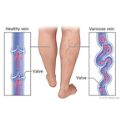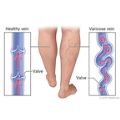Self-Care
Self-care, or home treatment, is recommended for most people with varicose veinsvaricose veins. Home treatment may relieve symptoms and slow down the progress of varicose veins. For many people, home treatment is the only treatment they need.
Your doctor can help you create a home treatment plan that is right for you. Here are some examples of things you can do at home.
- Exercise.
Exercise can help relieve symptoms and slow the progression of varicose veins by improving blood circulation in your legs.
- Try to take several short walks every day.
- Try to do moderate activitymoderate activity for at least 2½ hours a week. Or do vigorous activityvigorous activity for at least 1¼ hours a week. You can choose to do one or both types of activity. And it's fine to be active in shorter periods of time throughout the day and week that add up to the recommended goals.
- Do calf muscle exercises every day. When you are sitting down, rotate your feet at the ankles in both directions, making small circles. Extend your legs, and point and flex your feet.
- Stay at a healthy weight.
Staying at a healthy weight, and losing weight if you need to, may help relieve symptoms caused by your varicose veins. Being overweight can increase the swelling and discomfort of varicose veins.
- Elevate your legs.
When you elevate your legs, ideally at or above heart level, it helps keep the blood from pooling in your lower legs and improves blood flow to the rest of your body.
- Prop up your legs when you are sitting. Use a footrest at work and a footstool or ottoman at home to elevate your feet.
- Lie down and prop your legs above heart level. Try to do this for about 30 minutes at a time, about 3 times a day. You can lie in a recliner, bed, or couch with your feet propped on pillows to improve blood flow back to the heart.
- Avoid crossing your legs at the knees when sitting.
Keep your feet flat on the floor or cross them at the ankles. Crossing legs at the knees squeezes veins and blocks blood flow.
- Avoid long periods of sitting or standing.
Sitting or standing still for long periods of time puts added stress on the veins in your legs.
- If you stand when working, try to sit down for a few minutes regularly (with your feet up). Some people use a small stool to prop up first one foot, then the other when standing at work.
- If you are sitting, get up and move around every hour or so.
- Wear compression stockings.
Compression stockings are a main treatment for varicose veins that are causing symptoms. They improve circulation and help relieve symptoms.
- Take good care of your skin.
Your skin may be more fragile and even minor injuries can lead to skin ulcers.
- Treat cuts and scrapes on your legs right away.
- Keep your legs clean and moisturized to prevent drying and cracking.
- Prevent sunburns.
- Do not smoke.
Smoking can make varicose veins worse. If you need help quitting, talk to your doctor about stop-smoking programs and medicines. These can increase your chances of quitting for good.
Self-care for bruising or bleeding problems from a varicose vein
Varicose veins just under the skin sometimes cause minor problems. Most can be treated at home.
Minimize bruising
If you bump your leg, prop up your leg and apply ice or cold packs right away. Apply the ice or cold pack for 10 to 20 minutes, 3 or more times a day. Put a thin cloth between the ice and your skin.
Control bleeding
- Prop up your leg. Apply pressure over the site of the bleeding.
- Apply pressure for a full 15 minutes.
Mild bleeding usually stops on its own or slows to an ooze or trickle after 15 minutes of pressure. It may ooze or trickle for up to 45 minutes. Call your doctor if the bleeding does not stop after 45 minutes.
Care for a small blood clot in a varicose vein
Follow your doctor's instructions. Care may include the following:
- Prop up your leg and apply a damp cloth that is warm or cool.
- Ask your doctor if you can take an over-the-counter pain medicine.
Talk to your doctor if you have questions.
Learn more
- Compression Stockings: How to Use ThemCompression Stockings: How to Use Them
- Fitness: Getting and Staying ActiveFitness: Getting and Staying Active
- Weight ManagementWeight Management

